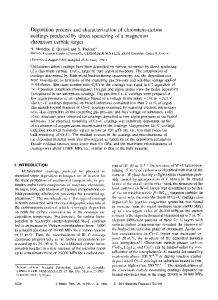Deposition of Lead-Silicate Glassy Thin Coatings by Rf Magnetron Sputtering: Correlation Between Deposition Parameters a
- PDF / 360,408 Bytes
- 6 Pages / 414.72 x 648 pts Page_size
- 74 Downloads / 375 Views
thicknesses from 50 to 1000 nm; here a conceivable conduction mechanism could involve hopping between electronic localized states within the energy gap or thermally activated electronic processes in the band tails. With 10-20% hydrogen in the deposition Ar atmosphere, 2 considerable Pb + reduction occurs and metallic lead clusters are detected by X-Ray Diffraction (XRD); the sheet resistance drops to 103-108 Q/0 due to electron tunnelling between disconnected metallic clusters. In atmospheres containing a low percentage of oxygen (1-10%), the room temperature sheet resistance becomes greater than 1016 Q/". As a matter of fact, metallic lead in these films is absent according to X-ray Photoelectron Spectroscopy (XPS) [5], XRD [7] and Raman spectroscopy [6] data. Beside these parameters related to the chemistry of the process, other parameters may also affect the electrical properties of our films. In this paper we report a study on the relationship between the substrate temperature and the target composition on the electrical properties of the films. While in previous works [5, 6, 7] temperature was kept constant, in the present work its influence has been carefully investigated.
285 Mat. Res. Soc. Symp. Proc. Vol. 396 01996 Materials Research Society
EXPERIMENT The lead-silicate glassy films were deposited by RF Magnetron Sputtering (13.56 MHz) in pure (99.9999%) argon atmosphere, at a pressure of 3 mTorr. The depositions were realized at a low value of rf power (45 W) to avoid the glass target surface melting. The target DC self-bias was -250±30 V. The sample holder (a 125x125x18 mm3 copper slab) was kept at a floating potential by means of a polymeric break. The sample holder floating potential (monitored with oscilloscope) was the same (-2.0±0.4 V) for all the depositions. The target-substrate distance could be regulated from about 0 to 40 cm. Two thermoresistors inside the sample holder could heat a sample up to about 500'C. Before starting the deposition, the temperature was measured in two different points on the sample holder surface by two thermocouples to verify the temperature uniformity. In the temperature range interesting to this work (20-120TC), these two thermocouples gave the same temperature values. During the depositions, the sample holder temperature was also monitored by two thermocouples. The first one (sensitive tip end of 0.5 mm diameter) measured the temperature on the sample holder surface next to the substrates; in order to optimize the thermal contact, a silver epoxy drop was put on the sensitive end. The second thermocouple (sensitive tip end diameter: 3 mm) was inserted into the sample holder and gave a reference value. The temperature oscillations were kept within ±0.5 'C by means of a water or air cooling system, particularly efficient in the range 20-200'C. Different substrates (graphite, silicon and sapphire) were put on the sample holder surface and targets of different composition were used. All the depositions were characterized by a greater target-substrate distance (35 cm) wi
Data Loading...










